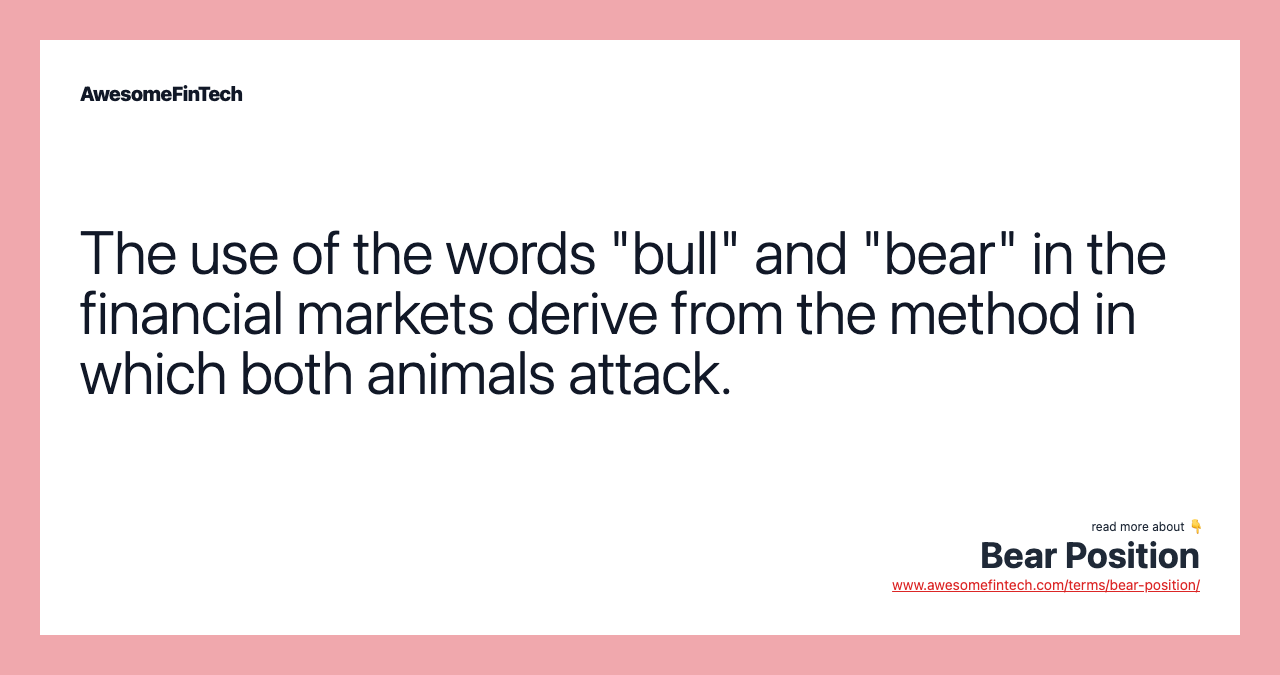Bear Position
A bear position is a short position applied to a financial security with the belief that the price or value of the security will decrease, resulting in a profit from the short position. A bear position is a short position applied to a financial security with the belief that the price or value of the security will decrease, resulting in a profit from the short position. A bear position is in contrast to a bull position, or long position, in which the value of the security can move against the investor or trader’s position only by a specific amount, to zero. A bear position is in contrast to a bull position, or long position, which expects that the price of a security will rise. A bear position is a short position taken on a financial security with the expectation that the price or value of the security will decrease.

What Is a Bear Position?
A bear position is a short position applied to a financial security with the belief that the price or value of the security will decrease, resulting in a profit from the short position.






How a Bear Position Works
A bear position is the inverse of a bull position. A bear, or short, position is a bet against the price of a trade or investment rising or staying flat. A bear position seeks to profit by estimating that prices will fall for certain securities in the market. This determination is usually based on the research of the investor or trader.
The seller that takes the bear position, or the short position, is called a short seller and will borrow securities, hoping for prices to decline. If the price falls, the investor will profit from the change in price. If the price goes up, the investor or trader will take a loss and may be exposed to unlimited losses because the price of the security has the potential to continue to rise.
A bear position is in contrast to a bull position, or long position, in which the value of the security can move against the investor or trader’s position only by a specific amount, to zero. Using alternative strategies when initiating a bear or short position can work to mitigate some of the risks of the unlimited rising price.
There are a number of alternative ways to take bear positions. Examples of this include buying a put option, which would entitle the buyer to sell a portion of their security within a fixed period of time. A put option is not an obligation to sell but rather an option to do so. Buying inverse ETFs, which are exchange traded funds (ETFs) built from a variety of derivatives, allows a buyer to profit from a decline in expected security performance. Another possible bear position is simply taking a short position on a specific stock.
Comparing the Usage of "Bear" in Market Terminology
The use of a bear and a bull are commonly applied to market discussions and reflect the way that both of these animals attack. A bull will thrust its horns upward, while a bear throws its paws downward. These upward or downward positions track market shifts.
A bear market, for example, is a market condition in which the price of securities decline and dwindling investor confidence leads to a self-sustaining, downward spiral in the stock market. This means that investors will expect more losses as the general pessimism increases. Although figures vary, a downturn of 20% or more over a two-month period from a peak in broad market indexes can be considered an entry into a bear market.
The meaning of a dollar bear is, once again, reflective of a negative outlook on the market. In this case, it’s an investor’s outlook for the U.S. dollar against other currencies, expecting a decline. A bear fund is a mutual fund that, amid market downturns, predicts higher returns for investors.
A covered bear is a strategy where a trader makes a short sale against a long position. This bear spread strategy aims to gain when the value of the security falls, but also includes a hedge. This structure puts a limit on losses, whereas a naked short can be subject to much higher losses.
Related terms:
Bear Market : Phases & Examples
A bear market occurs when prices in the market fall by 20% or more. read more
Bull Position
A bull position, also known as a long position, is one where the investor profits when the price of the investment rises. read more
Bull
A bull is an investor who invests in a security expecting the price will rise. Discover what bullish investors look for in stocks and other assets. read more
Covered Bear
A covered bear is a trading strategy in which a short sale is made on a long position involving stock the investor owns. read more
Derivative
A derivative is a securitized contract whose value is dependent upon one or more underlying assets. Its price is determined by fluctuations in that asset. read more
Directional Trading
Directional trading refers to strategies based on the investor's view of the up or down movement of the market or a security. read more
Dollar Bear
A dollar bear is an investor who is pessimistic, or "bearish," about the prospects of the U.S. dollar (USD). They are the opposite of a dollar bull. read more
Exchange Traded Fund (ETF) and Overview
An exchange traded fund (ETF) is a basket of securities that tracks an underlying index. ETFs can contain investments such as stocks and bonds. read more
Hedge
A hedge is a type of investment that is intended to reduce the risk of adverse price movements in an asset. read more
Long Position
A long position conveys bullish intent as an investor will purchase the security with the hope that it will increase in value. read more